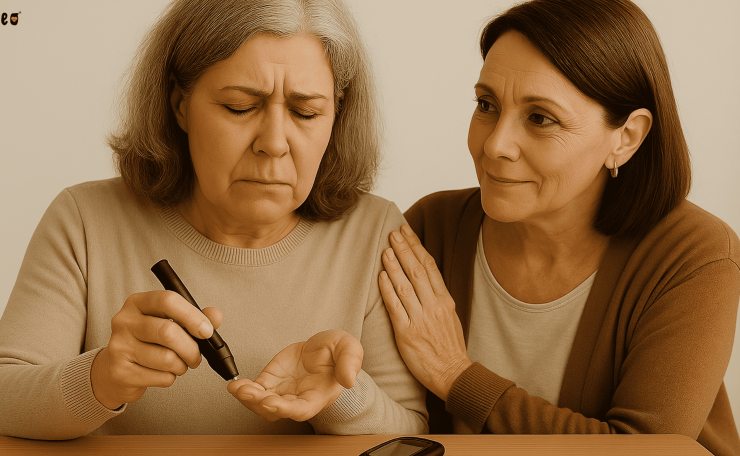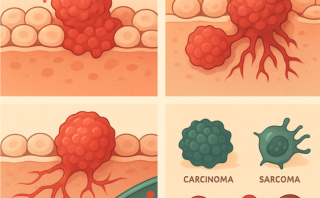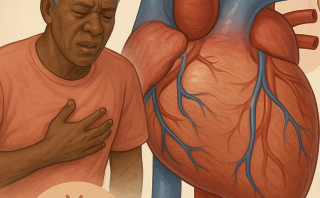Learn what diabetes is, how to spot it early, manage it well, and even prevent it.
Diabetes is a condition that affects millions of people, but you don’t have to be a medical expert to understand it. Let’s break down the basics—from what diabetes means to how you can stay healthy if you have it or are at risk.
What is Diabetes?
Diabetes is a health problem that happens when your body struggles to make or use a hormone called insulin. Insulin is made by your pancreas (an organ behind your stomach). Its main job? Helping your body use and store the sugar and fat from the food you eat.
If you have diabetes, it means:
- Your body doesn’t make any insulin,
- It doesn’t make enough insulin,
- Or your body doesn’t use insulin well (called insulin resistance).
As a result, sugar (glucose) builds up in your blood instead of fueling your cells. Over time, too much sugar in your blood can cause serious health problems.
Surprisingly, about 1 in 4 Americans with diabetes don’t even know they have it. Plus, nearly 100 million people have prediabetes—higher-than-normal blood sugar, but not high enough to be diabetes yet.
Why is Insulin Important?
Every time you eat, your body turns much of your food into glucose, a type of sugar. Glucose travels through your blood to your cells, which use it for energy.
Insulin acts like a key, helping glucose get into your cells. When your blood sugar goes up after a meal, your pancreas releases more insulin.
If your blood sugar drops too low, your body tells you to eat, or releases stored sugar from your liver. In diabetes, this delicate balance doesn’t work right, and sugar piles up in your blood.
Doctors usually diagnose diabetes when your fasting blood sugar (after not eating overnight) is 126 mg/dL or higher.
Types of Diabetes
There’s more than one type of diabetes. Here’s what you should know:
Type 1 Diabetes
-
What happens: The body’s immune system mistakenly attacks and destroys the insulin-producing cells in the pancreas.
-
Who it affects: Most often diagnosed in children or teenagers, though it can develop at any age.
-
What it means: The body stops making insulin entirely. Daily insulin injections or an insulin pump are necessary for survival.
Type 2 Diabetes
-
Most common form: Over 36 million Americans live with type 2 diabetes.
-
What happens: The body either doesn’t produce enough insulin or doesn’t respond to it properly (insulin resistance).
-
Who it affects: Typically occurs in adults over 40—especially those who are overweight—but it’s increasingly being diagnosed in younger people due to rising obesity rates.
Prediabetes
-
Early warning stage: Affects around 1 in 3 American adults.
-
What happens: Blood sugar levels are elevated but not high enough for a diabetes diagnosis.
-
Symptoms: Usually none—but internal damage may already be starting.
-
Why it matters: Catching it early gives you the chance to reverse it through lifestyle changes like healthier eating and increased physical activity.
Gestational Diabetes
-
What causes it: Hormonal shifts during pregnancy can lead to insulin resistance.
-
Who’s at risk: Pregnant women—especially those over 25 or with a higher body weight.
-
What it means: Typically resolves after delivery, but it increases the mother’s future risk of developing type 2 diabetes.
Other Forms of Diabetes
-
Monogenic diabetes: A rare form caused by specific genetic mutations.
-
Type 3c diabetes: Results from direct damage to the pancreas—due to surgery, disease, or injury.
-
Type 3 diabetes (theory): A proposed link between insulin resistance in the brain and Alzheimer’s disease, though this classification is still under scientific discussion.
Diabetes Symptoms: What to Watch For
Symptoms can be different depending on your type, and sometimes there aren’t any at all! Here’s what to look out for:
-
Type 1 diabetes (often sudden and severe):
– Extreme thirst and hunger
– Peeing more than usual
– Dry mouth
– Unexplained weight loss
– Feeling tired or weak
– Blurry vision
– Rapid, deep breathing (rare)
– Fainting (rare) -
Type 2 diabetes:
– Similar to type 1, but often milder and sneakier
– Slow-healing sores/cuts
– Itchy skin, rashes, or infections (especially yeast)
– Numbness or tingling hands/feet
– Erectile dysfunction -
Gestational diabetes:
Usually doesn’t cause symptoms, but may notice extra thirst, hunger, or urination (which also happens in normal pregnancy).
How is Diabetes Diagnosed?
If you have symptoms or risk factors (like being over 35 and overweight), your doctor may suggest a test.
Here are some common tests that your doctor may suggest-
- A1c Test: Measures your average blood sugar over 2-3 months. ≥6.5% means diabetes.
- Fasting Blood Sugar: After not eating for 8 hours. ≥126 mg/dL = diabetes.
- Random Blood Sugar: Anytime. ≥200 mg/dL suggests diabetes.
- Glucose Tolerance Test: Test after drinking sweet liquid. Measures how your blood sugar changes.
- Other tests: May include antibody tests (to check for type 1 diabetes) or ketone checks (if you’re feeling ill).
How is Diabetes Treated?
While there’s no cure yet, diabetes can be managed! The main goals are to:
- Keep your blood sugar in a healthy range.
- Manage your cholesterol and blood pressure.
- Prevent problems like nerve, eye, or kidney damage.
Treatment may include:
- Checking your blood sugar sometimes daily, sometimes just at checkups.
- Insulin injections or pumps for type 1 diabetes, and sometimes for type 2.
- Other medications: Pills or injections that help your body use insulin better.
Common meds for type 2-
– Metformin
– Sulfonylureas
– SGLT2 inhibitors
– DPP-4 inhibitors
– TZDs
– GLP-1 agonists can help with blood sugar and even weight loss. - Healthy eating: Enjoy lots of fruits, veggies, whole grains, lean protein, and healthy fats. Limit sugary foods, drinks, salt, refined grains, and alcohol.
- Staying active: Aim for 30 minutes of moderate movement (walk, swim, dance, bike) at least 5 days a week.
- Lifestyle habits: Manage stress, don’t smoke, keep a healthy weight, and keep regular checkups.
Remember: day-to-day self-care makes the biggest difference!
Can Diabetes Be Prevented?
You can’t prevent type 1 diabetes. But for type 2, healthy habits make a huge impact:
- Eat nutritious food (fruits, veggies, whole grains).
- Move your body regularly.
- Maintain a healthy weight.
- Get your blood sugar checked if you’re at risk.
Ask your doctor if meds or other steps might help if you’re at high risk.
Top Takeaways
- Diabetes means your body struggles with insulin, causing high blood sugar.
- There’s no cure, but you can manage it—and prevent complications.
- Type 2 diabetes is most common and often preventable.
- Healthy lifestyle choices are your superpower!
- Check with your doctor if you have symptoms or are at high risk.
Diabetes FAQs
Q: Can diabetes be reversed? A: Type 2 diabetes can sometimes go into “remission,” especially after weight loss—but it’s not a cure, and it can come back. Type 1 diabetes can’t be reversed.
Q: If I need insulin, is it forever? A: Maybe not. It’s sometimes a temporary help for type 2 diabetes, especially if you make big changes to your lifestyle.
Q: Do sugary drinks cause diabetes? A: Not directly, but lots of sugar raises your risk—and drinking sugary drinks daily has been linked to a higher chance of type 2 diabetes.
Q: How can I lower my blood sugar fast? A: Fast-acting insulin, drinking water, or gentle exercise may help. But if you’re not feeling well or suspect a complication, call your doctor ASAP.
The Bottom Line
Diabetes can feel overwhelming, but with knowledge and the right habits, you can take charge of your health. Think you might be at risk? Call your doctor, get checked out, and start making healthy changes today!
Note: This article is for informational purposes only and is not intended as medical advice. Always consult a licensed healthcare provider for treatment decisions.
Sources:


